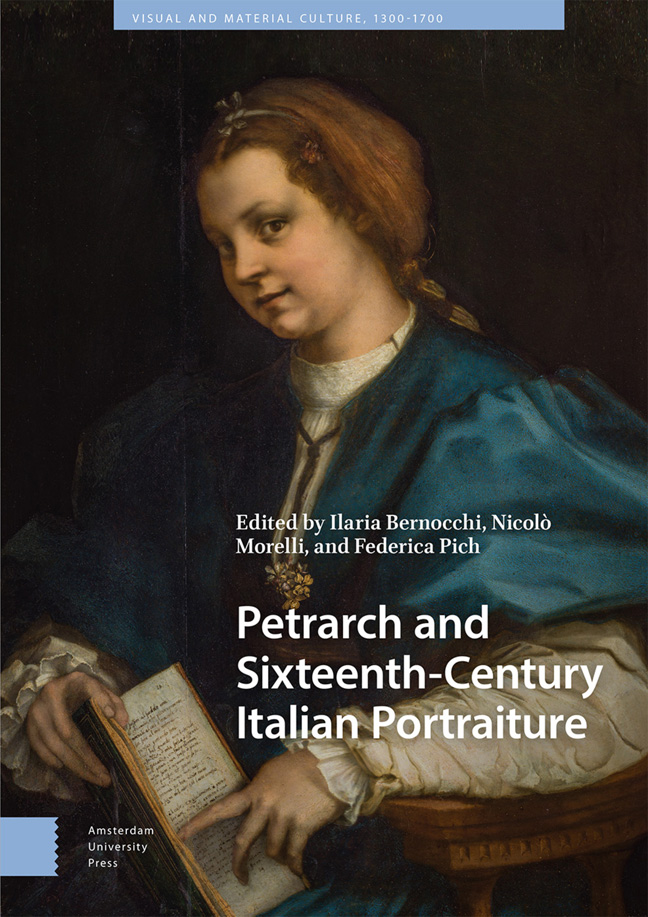Book contents
- Frontmatter
- Contents
- List of Illustrations
- Acknowledgements
- 1 Introduction
- 2 Widows, Poetry, and Portraits: Livia Spinola and Francesca Turina on the Portraits of their Dead Husbands
- 3 In Medusa's Eyes: Petrification and Marble Portraits in Late Sixteenth-Century Poetry
- 4 The Portrait of the Ideal Woman: Petrarch in Conduct Literature Texts for and about Women
- 5 Anti-Petrarchist Portraiture or a Different Petrarchist Portraiture?: A Literary Outlook on Some Non-Idealised Female Sitters in Renaissance Art
- 6 The Shadow of Petrarch: Benedetto Varchi and Agnolo Bronzino on Portraiture
- 7 Double Portraits of Petrarch and Laura in Print (c. 1544–1600)
- 8 Sonnet ‘Diptychs’ and Double Portraits: Figurative Allusions in Sixteenth-Century Encomiastic Poetry
- 9 Images of Women from Subject to Frame in Printed Portrait Books
- Bibliography
- Index
9 - Images of Women from Subject to Frame in Printed Portrait Books
Published online by Cambridge University Press: 22 February 2024
- Frontmatter
- Contents
- List of Illustrations
- Acknowledgements
- 1 Introduction
- 2 Widows, Poetry, and Portraits: Livia Spinola and Francesca Turina on the Portraits of their Dead Husbands
- 3 In Medusa's Eyes: Petrification and Marble Portraits in Late Sixteenth-Century Poetry
- 4 The Portrait of the Ideal Woman: Petrarch in Conduct Literature Texts for and about Women
- 5 Anti-Petrarchist Portraiture or a Different Petrarchist Portraiture?: A Literary Outlook on Some Non-Idealised Female Sitters in Renaissance Art
- 6 The Shadow of Petrarch: Benedetto Varchi and Agnolo Bronzino on Portraiture
- 7 Double Portraits of Petrarch and Laura in Print (c. 1544–1600)
- 8 Sonnet ‘Diptychs’ and Double Portraits: Figurative Allusions in Sixteenth-Century Encomiastic Poetry
- 9 Images of Women from Subject to Frame in Printed Portrait Books
- Bibliography
- Index
Summary
Abstract
In the mid-sixteenth century, images of women disappeared from the popular genre of printed portrait books. Portraits in early volumes, from 1517 to around 1558, were presented both as exemplars and via physiognomic tropes that presumed character was visible in the face. Yet famous (or infamous) women's biographies often contradicted the chaste beauty typical of these depictions. Responses by authors and printmakers across Europe suggest that portrait books staged a clash between imagined ideal women, whose images drew from Petrarchan beauty tropes, and a new taste for seductive or grotesque female bodies. By the 1570s, women appeared primarily in the frames of men's portraits or as models for historical costumes: the specificity of their lives was elided; whether ideal or grotesque, women were all surface.
Keywords: portrait book, costume book, Lucretius, Enea Vico, Jacopo da Strada, Francesco Terzio
Petrarch famously wrote of the ‘bel viso leggiadro che depinto | porto nel petto’ [lovely smiling face, which I carry painted in my breast] (Rvf 96.5–6). In the sixteenth century, it became possible to literalise Petrarch's words: as Gemma Cornetti points out in this volume, printers produced images of Petrarch and Laura in heart-shaped frames. Likewise, readers could carry a ‘bel viso leggiadro’ close to the heart, as collections of printed illustrated biographies developed into the portrait-book genre. The earliest of these volumes, published in the decades between 1517 and 1560, were in fact small enough to carry around. While Petrarch's Laura was constructed from an idea, an ideal ‘pattern’ of what a beloved should be, early sixteenth-century printmakers used traditional beauty tropes to create images of Roman empresses for books of ancient coins. Female portraits comprised a significant proportion of these early volumes, only to disappear by the 1560s. Portraits of women were almost entirely eliminated at the very moment that the coin-volume genre evolved into the portrait book, which typically displayed a large image of a famous person alongside their biography. The disappearance of women's images has far-reaching consequences, since portrait books evolved into the biographical encyclopaedia by the seventeenth century: women were eliminated from illustrated histories just as these volumes became widely disseminated and more standardised through print.
This chapter will look at interactions between text and image in several sixteenthcentury portrait books from Italy, France, Switzerland, and Austria, to ask if and how Petrarchan canons contributed to the elimination of women's images from early popular histories.
- Type
- Chapter
- Information
- Petrarch and Sixteenth-Century Italian Portraiture , pp. 213 - 240Publisher: Amsterdam University PressPrint publication year: 2023



